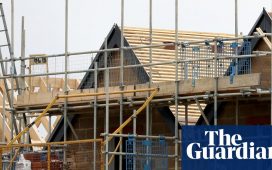Stay informed with free updates
Simply sign up to the UK house prices myFT Digest — delivered directly to your inbox.
UK house prices fell at the fastest pace in more than a decade in the year to October, with the biggest drops in London, according to official data that points to the impact of high interest rates on the property market.
Average UK house prices declined by 1.2 per cent in the 12 months to October 2023, down from a revised fall of 0.6 per cent in September, the Office for National Statistics said on Wednesday.
It was the largest drop since October 2011 and left the average house price at £288,000, some £3,000 lower than 12 months ago.
London was the UK region with the biggest contraction of 3.6 per cent, the largest fall since August 2009. But the capital remained the most expensive part of the country, with the average home costing just over £515,500.
Official data is the most comprehensive measure of UK house prices because it includes cash purchases, unlike other indices. But since they are based on deals finalised in October, which might have been agreed several months earlier, the figures are less timely than those of Halifax and Nationwide.
Their indices are based on mortgages agreed in the latest month, and both lenders reported an easing in the annual decline in house prices in November.

The fall in prices in October reflects the impact of high mortgage rates on the property market, after the Bank of England raised the cost of borrowing from a record low of 0.1 per cent in November 2021 to a 15-year high of 5.25 per cent.
But with inflation falling more than expected to 3.9 per cent last month, markets expect the central bank’s Monetary Policy Committee to begin cutting interest rates early next year.
Tom Bill, head of UK residential research at estate agency Knight Frank, said mortgage providers would come under more pressure to reduce rates on their products after the latest inflation data, “which means the property market should see a seasonal pick-up in transactions next spring”.
He added that the general election to be held next year had “become the biggest uncertainty facing the market but the worst of the economic news increasingly feels behind us”.
Most regions across the UK reported an annual contraction in property costs. Scotland and the north-east of England were the only two parts of the country that registered growth.
Those declines could worsen, the ONS said, as it warned that house prices were subject to greater revision than usual because of the historical low levels of transactions.

Wednesday’s data also showed UK rental prices rose by an annual rate of 6.2 per cent in November, up from 6.1 per cent in October and the highest annual increase since the ONS began collecting figures in January 2016.
Rental demand has risen because of households not being able to afford mortgage payments. Rental prices are also boosted by landlords passing on higher borrowing costs and a shortage of properties available to rent.
Anna Clare Harper, chief executive of GreenResi, a sustainable investment adviser, said the reading of 6.2 per cent — which includes existing and new rental contracts — “underestimates the reality many renters face, as rental price increases for new tenancies are often at least double this figure”.
“It is critical that the volume and quality of supply of rental homes improves, which requires professional investors to step in as traditional sideline private landlords exit in droves,” she added.










